Fiorucci Made Me Normcore: Five observations on art, style, and scenes today Philipp Ekardt
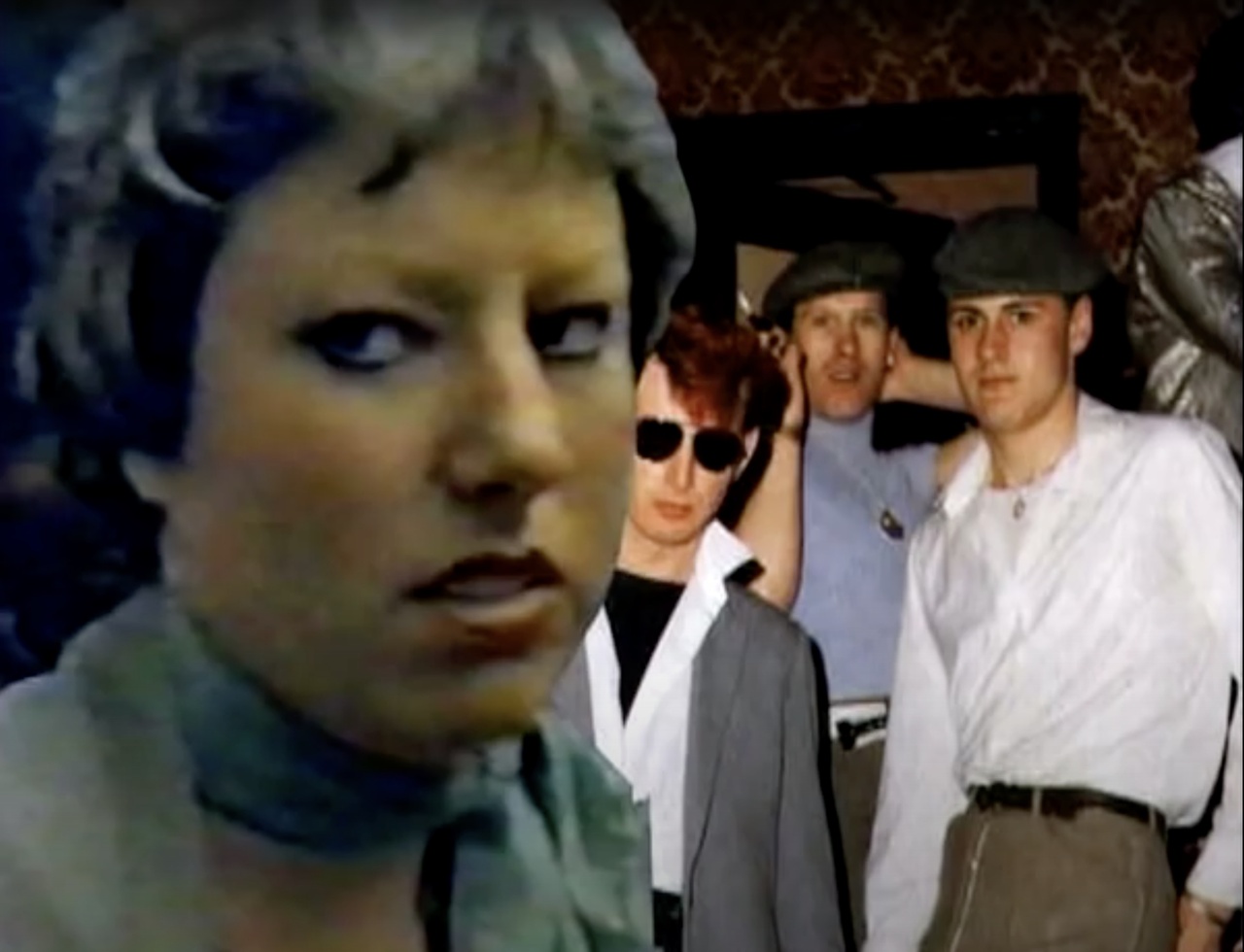
Mark Leckey, „Fiorucci Made Me Hardcore“, 1999, Filmstill / film still
1. When Art Turns to Scenes
When conceiving of the interrelation between art and social scenes, the connection is almost always made unilaterally by understanding the artwork as a product that emerges from a social subgroup whose members are accordingly seen as producers. While appealing to common sense, such a perspective suffers from a certain heuristics that is production-biased: The artwork, its aesthetic properties, formal features, structures etcetera, are understood as emerging from a social scenario, and even in the least possible sociologically deterministic mode, the explanatory power here flows from “group of people” to “(group of) work(s).” The connection can be remodeled in functional terms by asking what advantages, or disadvantages, result for the producers of art from the fact that they make such works. This functionalist approach is still people-centric and can, in a vaguely Bourdieuian manner, for example, address the accumulation of social capital through inhabiting the otherwise often economically disadvantageous position of being an art-producer. Such an approach enables, for example, a decoding of bohemian romanticism as a folktale-version of the story of art that is now interpreted as a quid pro quo plot of renunciation and unexpected gains: Life among the outcasts of honorable society can, after all, function as a distinction mechanism, because the financially precariously situated makers of art wallow in the subcultural riches of a place formerly known as “Bohemia.”
Per se there is nothing wrong with these approaches. However, they are misleading and, in fact, inept when it comes to judging certain cases in art, of which, it seems, we are recently facing an increasing number, where the work in question turns to social scenes, subgroups, “the underground,” etcetera (let’s bracket these terminological, sociological, and stylistic negotiations for the present case), and begins to integrate these scenes into its facture in the broadest sense of the term (“depicts,” “shows,” “talks about,” “makes visible” etc. – again, let’s postpone this conceptual fine-tuning to a later point). I will unsystematically and non-evaluatively name a few examples (none of these bodies of work – it should be noted – can be reduced to this interest in the socio-aesthetic; and all of them are otherwise separated by vast differences in terms of the nature of these artistic projects and would, by some, be judged to be of differing artistic quality; a judgment that I’ll also suspend for the moment).
For instance, think of Wolfgang Tillmans who in his work has dedicated sustained photographic attention to the formal and aesthetic inventory, the styles, shapes, textures, surfaces etcetera, the looks and bodies which emerged on the streets, in clubs, in studios, of London, Berlin, New York in a generation that travelled the orbit of queer techno, rave, and art contexts. Or, take a practice like Calla Henkel’s and Max Pitegoff’s whose photographs and sculptures center on and sometimes literally incorporate the architecture and object-infrastructure around which various types of social traffic and exchanges take place (“underground”/“art-related,” as, for example, in their works deriving from Berlin’s Times bar or New Theater; but also in other professional contexts, e.g., in Berlin’s new digital startup culture). Think of the packs of roaming, emaciated youths that Ryan McGinley used to take on road trips through the American countryside, where he sent them into caves, made them run through showers of crackling firework, or placed them in branches high up in trees; by some accounts a displaced pack of lower east side skater teens and twenty-somethings. Or, turn to the work of artists Stewart Uoo and Wu Tsang, who, in some of their photographic and filmic output have staged the protagonists of the queer scenes that surround them in New York and Los Angeles respectively. While the individual position of all of these artists within those scenes may be of differing quality (some are observers, some are “members” all are certainly set apart through the comparatively high degree of attention that their work has received in criticism, publication, and art institutions), their above-mentioned work seeks to connect with the sociality that plays out in those groups.
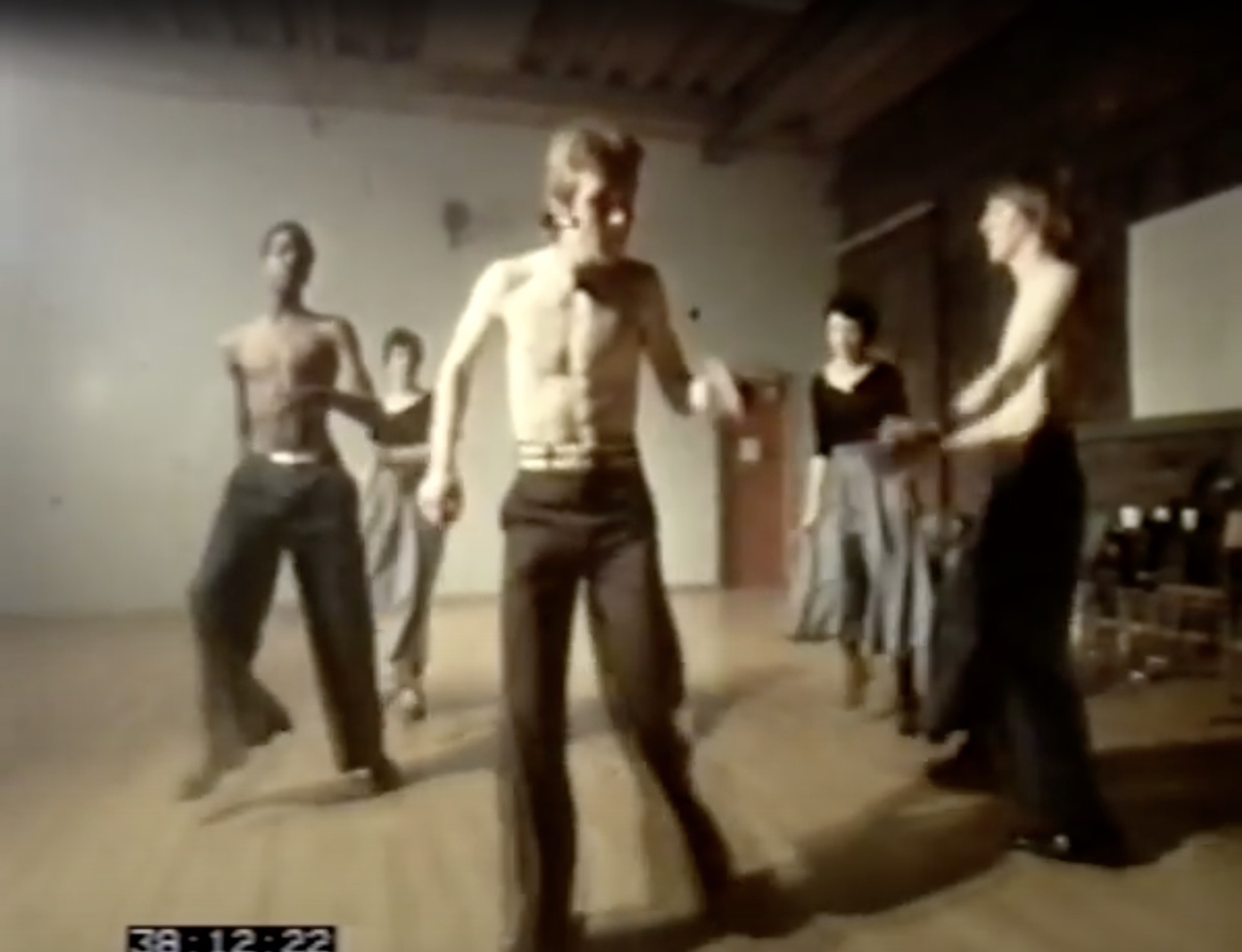
Mark Leckey, „Fiorucci Made Me Hardcore“, 1999, Filmstill / film still
While a full understanding and potential appreciation and judgment of these works certainly has to integrate knowledge about the scenes in question, these evaluative acts are not essentially framed by such an acquaintance. In all of the mentioned cases, the specific relation that is established between art and the social scene distinguishes the work qua art, and against other artworks, which may or may not entertain (dis)similar connections. But this is still a distinction that is operative on the plane of art, not on the level of the social. There certainly is an analysis that dissects the art/sociality-nexus from the perspective of the social – as witnessed, e.g. in the present journal’s recent issue “The Gallerists” (or, previously, “The Collectors” and The Curators). But such a sociology of the art world maps the terrain in a manner that is incongruous to the one that vises thematically scene-connected artwork.
2. Work in the Mines of the Socio-Aesthetic
What frequently remains curiously unexamined is the very nature of the relation that scene-connected artwork entertains to the very socio(-stylistic) formations it puts on display. In a number of cases, the comparable permanence and stability, which such art secures for its socio-stylistic objects, is certainly welcome. After all, these aesthetic articulations and formations reside in the socio-stylistic traffic that in turn makes up those scenes; a fleeting and notoriously under-documented activity, which if unrecorded, frequently enough vanishes with the memory of its participants (although this may be a perfectly valid option). However, in contrast to a predominantly documentary mode, the work in question here is not identical with a mostly recording/reporting-oriented practice. In some of these cases the scenery that such art accesses will inevitably contribute to its artistic/aesthetic differential value. And this is where things become more ambivalent, if not outright tricky to assess. Because there is hardly a way around the acknowledgment that within the parameters of the art system, the socio-stylistic productivity that goes on in those scenes carries the potential of being converted into a resource that fuels an aesthetic surplus on the level of the artwork. And under what conditions this is okay is debatable.
One way to conceptualize this link could lie in a model that is now about half a century old, but still valid. In his study “Mythologies,” Roland Barthes described processes of mythification as a relation between two levels of signification, whereby one level is accessed, referentialised, and effectively semiotically coopted by another level; in less friendly terms one could speak of a parasitical relationship, or, more technically, one could describe myth – with Barthes – as a second-order language that feeds on the activities in a first-order signifying chain. [1] In this manner an array of signs – for example (an image of) a stack of Italian produce, wine, espresso, pasta etcetera – could be turned into a signifying mass that now, by having been reduced in its referential differentiation and complexity, merely signified that specific type of primary complexity: e.g. Italianicity, for the purpose of advertising. In the current context it is less the semiotic aspects that matter; what is crucial is that Barthes allows us to think that the level which is accessed by the “secondary language” now functions as resource; and that it has been turned into such “primary raw material” not because it existed as such to begin with; but rather in the very process of mythification by which it became “colonized.” Leaving the problem of myth aside, it seems plausible to recognize a similar mechanism at work in a certain manner in which art accesses the social and aesthetic productivity of scenes. It must be noted that in each specific case, a careful analysis must take place to assess whether the work in question falls under these circumstances. But on a general level, these scenes effectively acquire the status of primary resources upon which to draw. One doesn’t need a theory of biopolitics or subject-capitalism (although both terms can certainly be helpful in staking out the framework of this issues) to realize that there’s a mining process going on.
3. The Problem of Protagonism
Take another more or less recent example that connects to a more historical stratum of the problem: The cover of Antony and the Johnsons’ 2005 album “I am a Bird Now” makes use of Peter Hujar’s 1974 shot of Candy Darling on her deathbed. It’s a moving, sad, and beautiful image. Candy’s self-stylization in the face of her impending death as pneumonic Mimi, including a décor of white camellias, and Hujar’s willingness to participate in this acceptance of mortality and the transfiguration of bodily withering into beauty is staggering; the image deserves to be called nothing but radical. However, what do we make of this picture’s very swift appropriation for a record cover? What about the implicit, rather direct tapping into the wells of the Candy Darling myth, that comes with all the accoutrements of the Warhol scene that Darling traversed. This – and other incessantly popular recourses to the personnel of Warhol’s Factory – seem to be haunted by a transformation of what in retrospect appears to be a self-fulfilling prophecy, namely the underground positing of superstardom, the peculiar counter/adaptation to the studio system of the culture industry, which resulted in a phenomenon that one could call protagonism: The protagonist’s name stays with us, but the at one time very palpable and complex socio-stylistic values associated with that existence vanish behind its invocation. Next to nobody now remembers Candy Darling for her actual style, but in her function as a persona in the Warhol cosmos.
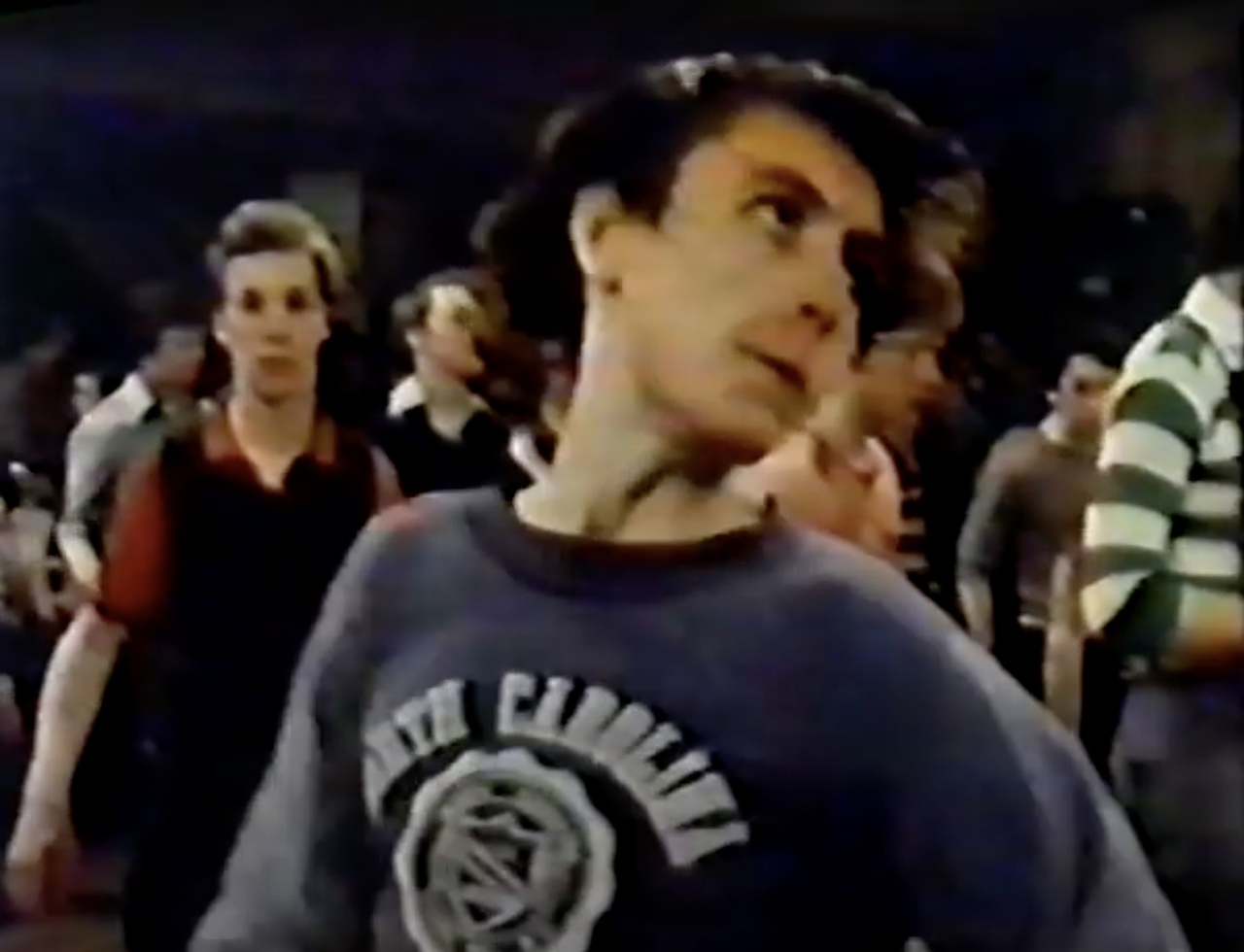
Mark Leckey, „Fiorucci Made Me Hardcore“, 1999, Filmstill / film still
Related cases – from outside the field of art – come to mind: Think of the familiarity with which one can refer to Venus Xtravanganza, Octavia Saint Laurent, or Pepper LaBeija, now all deceased important figures in New York’s ballroom/voguing scene, all of which appeared in Jennie Livingston’s now canonical documentary “Paris is Burning” (Saint Laurent also in Wolfgang Busch’s 2006 follow-up-report on the scene “How Do I Look?”). Or, the array of characters that we encounter in Wu Tsang’s recent film “Wildness” (2012) which portrays the Latina/o transgender scene that congregates at the LA bar Silver Platter – a viable candidate for swift induction into the queer canon. The work done in each of these cases is highly laudable; not only do these films play a part in preserving modes of expression and interaction that might otherwise be lost, but the very gesture of dedicating attention to them is also one of respect and acknowledgment; Anerkennung (recognition) for a non-institutionalized aesthetic. Making the members of such scenes speak in front of the camera, is also vital in that it contributes to a collective representation of those lives as worthy of testimony, as livable, as communal, and, ultimately, regarding their frequently literally precarious state, as grievable.
However, those works’ basic structuring trope – to depict these scenes by way of a select number of individuals – perhaps also carries some ambivalence. It is one thing to, for example, filmically capture the panorama of socio-stylistic get ups that is integral to the Vogueing-scene which, after all, in part relies on the principle of an assumption of such roles (within the solidary communities of “Houses”; but also in the process of representing and walking in different categories on the Ballroom Runway). But it is another thing to access these scenes, intentionally or not, by depicting them as assemblies of such characters. The difficulty here does not lie in the fact that such “characters,” stylistically more pronounced figures who may have an intra-scene fame, actually exist or not – in some scenes they do. Rather, the potential challenge lies in not representing these scenes as their sum.
An approach that takes this into account would also require a critical reevaluation of the tools, strategies, and paradigms with which we have come to work over the past decades. One of the most forceful and productive impulses came through the application of the theory of performativity to the socio-aesthetic realm. Through transferring Austin’s speech act theory, Lacanian psychoanalysis, and Foucault’s theorization of power and discourse to, for example, the study of gender, Butler provided a framework in which also “underground” stylizations could be read as non-essentialist modes of subjectivation. (Famously and canonically: her reading of Livingston’s “Paris is Burning” in “Bodies that Matter.”) [2] Again, this was and is a highly necessary operation. However, if reinserted into the territory we’re looking at, it also leads to a skewed perspective: Here style tends to be conceptualized as a placeholder for the subject/individual and the site where such styles emerge (“the scene”) reads as an agglomeration of such acts of subjectivation through style. These may indeed be central for the respective involved persons and these acts may figure centrally in their biographies; but the underground conditions – and communities – in which these styles circulate cannot be reduced to such acts of individuation. They are also communities in which this knowledge circulates, is shared, altered, etcetera – in which styles roam and transform.
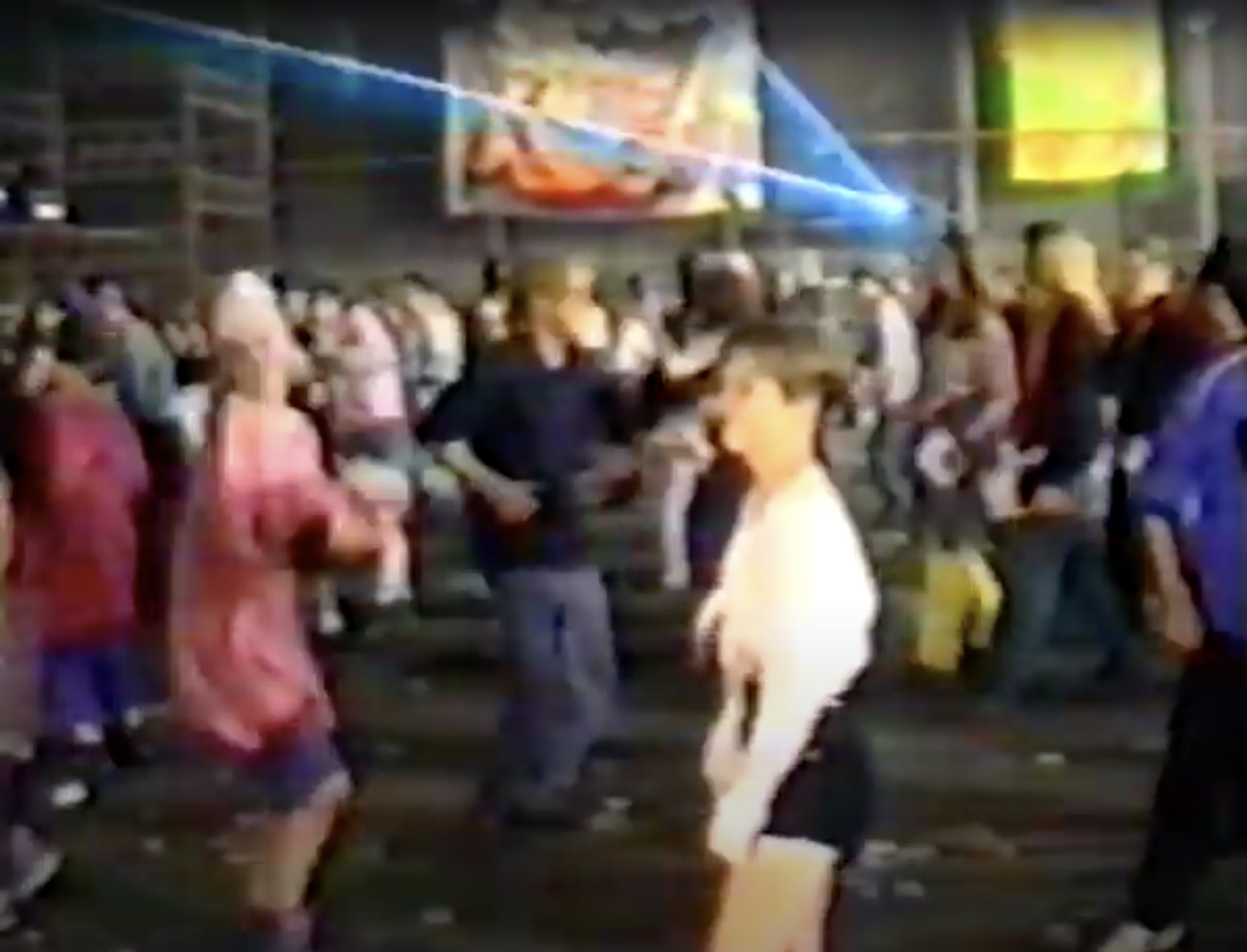
Mark Leckey, „Fiorucci Made Me Hardcore“, 1999, Filmstill / film still
In the end, the performatist approach to reading scenes casts all potential members as it-girls and it-guys. And whereas the perspective of entering a scenario in which everyone’s at least potentially endowed with the hotness, stylistic leadership, stand-out potential and marketability of an it-person may seem appealing to some, it is of course, not just vulgar, but also false. And not only because there can by definition only be a limited number of occupations of the it-position within a given scene. It is also problematic because the entire construction of the it-position obfuscates the social productivity from which stylistic potential emerges.
Another difficulty to this model is that this “performative” interpretation of style frequently comes with a theatrical bias; and by theatrical is meant dramatic. [3] Such an approach is helpful when tackling a situation of normative authenticism, because in its championing of Uneigentlichkeit (inauthenticity) it provides a model that is structurally opposed to any possible essentialist cooptation. However, when thinking about underground style in general it is also potentially problematic, because beyond its insistence on the mutual dependence, but also constitutive difference between subject and role/interpellation/discursive function, it offers no alternative to the mode of conceptualization of exercising style as adopting a role. It equivocates style with role-play.
4. Styles Mistaken For People
(Capitalist) exploitation is compatible with and enhances faciality, and it solicits processes that could be referred to – with a clumsy neologism – as faceification; a problem and phenomenon that, as political theorist Nina Power in a recent discussion at the “54321 … Radical Philosophy Conference” at Haus der Kulturen der Welt in Berlin explained, also posed itself to certain political activists in the Occupy movement who were addressed by news outlets with the request to speak to their “leader.” Seeking to circumvent the potentially detrimental effects of such an extraneous call for representation, a strategy was devised by which that role was filled with ever-new faces. [5] Bracketing a discussion of such a strategy’s political import, it is no less instructive to point to a parallel critical trope deployed by Deleuze/Guattari who theorized the potentially repressive effects of an implementation of such faciality (visageité).5 Transferred to our present context: When art turns to scenes and processes them, represents them (for whom?) in their entirety as a cast, set up, so they can be looked at, we can speak of a faceifying mode. Whereas an appropriation of the interpellation “Are you ready for your close-up?” “from below” could be understood as resistant from a standpoint that thematizes exclusion, such a strategy is potentially complicit in a situation in which access is key to the generation of value. Rhetorically the problem is one of prosopopoeia, of giving a face to something (stylistic activity) through which it can be addressed in a manner that works only as a long as the underlying activity is obfuscated. [6]
While the 19th century myth of origin for the emergence of a Bohème – a narrative of expulsion, exclusion, or exile – was a myth already at that time, it is only ever more clear now that such an account structurally over-emphasizes the role of the participants in their function as protagonists/actors. [7] Or, to drive home the tautology: It overemphasizes the role of “roles.” Regardless of how these social figurations may have specifically emerged in the 19th century, things look very different today. One could dig a level deeper, onto the stratum of (sub)systemic interrelations and say that the bohemian condition is that under which a scene’s members appear for vast parts of another – vaster – system (and to themselves) as (outcast) actors. Or, more succinctly put: Bohemia occurs when a scene poses for the mainstream as an ensemble of protagonists, as a cast of characters. In this sense the one central truth of the 19th century myth of the Bohème would have been its novelistic, or even more successfully, its operatic character. Just another anthropomorphic error, bohemia is styles mistaken for people.
A potential antidote would be a critique of representation as developed, for example, in the practice of post-dramatic theater; in which not just the specific economy of stand-ins between role, actor, text, and audience is problematized. [8] This is understood. Like, for example, in the practice of René Pollesch, which calls the very principle of representation as an economy in total into question. To which could be added an element of what literary theorist Emily Apter has termed a politics “smallest p,” which here would spell out a non-symbolic politics that questions representation as a daily (artistic) practice. [9]
5. Fiorucci Made Me Normcore
There is an anecdote about some young artists arriving at the Städelschule in Frankfurt/M. to study in Mark Leckey’s class. They had seen Leckey’s 1999 video “Fiorucci Made Me Hardcore,” a 15-minute found-footage montage that combines clips of dancing and roaming teens and twenty-somethings, a few scenes better looking than others, some sharp, others ridiculous, most disheveled, into a string of manifestations in movement and dress, with the film’s last third gravitating around material from rave parties, by the work’s title associated with the style of Gabba. It was especially these sections, or so the story goes, that had sparked the potential students’ interest, who instinctively seem to have participated in the beginning and since ever-growing re-appreciation of that historical style’s particular hardedge taste, which, in combination with a bricolage-sensibility, also infuses our present moment, from the looks of Russian designer Gosha Rubchinskiy to the aesthetic codes of much of post-Internet art.
The (unverified) story recounts the mutual puzzlement and confusion between the potential teacher who could, for better or worse, not instruct the potential students how to artistically and aesthetically “access” the scenes and stylistic communities that his video showed. In the context of the present discussion this perceived shortcoming can be read as a potentially productive quality. The straightforwardness and the distance with which the social and aesthetic realms of hardcore rave in the latter half of the film – presented by way of found footage – serve well enough to give its viewers an image and impression of their stylistic values; but they never participate in an ideology of faceification or access. There is no way in which Leckey’s video seeks to capitalize on a “proximity” to Gabba. Its title dryly sets the rough, often stylistically failing, at times Brutalist and trashy aesthetic of the dirtier edges of rave against the hyper-dramatized fashion of the Fiorucci brand, which ran a famous store on Park Avenue that employed personnel like Joey Arias and other Downtown regulars at nightclubs like the Pyramid. In Leckey’s piece this realm is evoked merely, but effectively, through the integration of a whispered sample from Sister Sledge’s “He’s the Greatest Dancer”: “Halston, Gucci, Fiorucci,” with the double-invocation of “Hardcore” and “Fiorucci” closing the video acoustically.
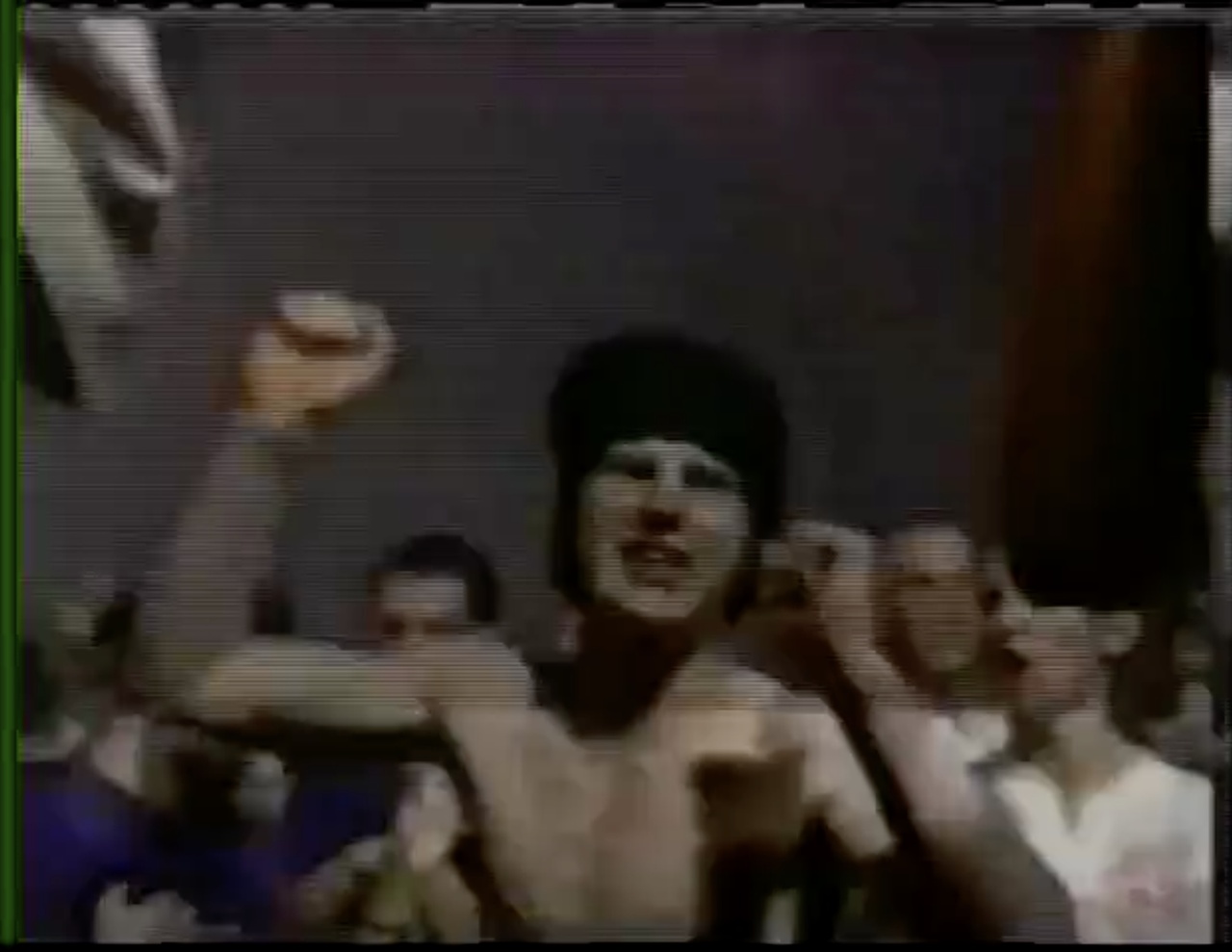
Mark Leckey, „Fiorucci Made Me Hardcore“, 1999, Filmstill / film still
What makes Leckey’s piece interesting in the present context is not that it potentially privileges Gabba over, say, gay hi nrg-house or the sounds of the Paradise Garage. It doesn’t. Nor does it present the most stylistically interesting, let alone appealing scenes. But through forming something like a late 1990s contrastive after-image to parts of that and the previous decade’s nightlife it presents us with an artistic reference to both eras and stylistic formations that is free of the protagonist iterations that otherwise tend to overtake the place of an actual aesthetic engagement with its styles. In this sense Leckey provides us with a case of an actual aesthetic interest in a style, not unlike designer Raf Simons whose first aesthetic education was, in his own account, the world of New Beat, and who has firmly retained his initial commitment to techno up to the point of using a soundtrack including tracks by Plastikman and A Number of Names for his first prêt-à-porter show at Dior. [10]
One of the central formal characteristics of Leckey’s piece that partly allows for such an anonymization is the classic use of montage; here of found footage. There is no reason for positing this approach as the high road for a “correct” treatment of social styles in artistic work. However, its time-honored leftist/formalist theorization, most forcefully put in Adorno’s work, still seems to hold true; namely, that if deployed in the right manner, montage can articulate material as material. [11] While styles may not per definition belong to the order of materials, such an approach still counters the tendency of treating them as exploitable resources.
Other examples from the realm of art and film come to mind. Take Charles Atlas’ masterfully staged 1986 “Hail the New Puritan,” which documents the work of the Michael Clark dance company, including their socio-aesthetic surroundings. The film features a smoothly choreographed sequence in which Clark moves through a nightclub, weaving and ducking through the crowd, all outfits carefully selected from combat boots to extravagant caftans crafted from nothing but golden chainlets. In single shot the camera assembles social interaction on all sorts of levels, from chats, making out, to dancing; montage then juxtaposes this voyage through a smooth space with a sequence on the dancefloor in which these movements and interactions merge with a strange repertoire of gestures, half signifying, half abstract, all choreographed by Clark; a moment in which being part of nightlife is not conceptualized as being part of a theater of a filmic cast. It’s likened to being part of a dance company. A company that still clearly has a star: Michael Clark in all his early beauty, virtuosity, flirtatiousness, and cockishness. But the intervention of formalization on all levels has also broken down any false pretense to coming close to Clark and his “friends” and instead generated a socio-stylistic analytic whose elegance can hardly be matched. The appreciation is one of technique.
Or, take the recently rekindled interest in the visual aesthetic of the visual work that accompanied the activities of 1990s/early 2000s house/techno-underground, organized around the label EMD, and partly present in art galleries in the carefully anonymized, controlled, liquid loops of Daniel Pflumm. At the time such work – and its concomitant social aesthetic – was in part directed against a bohemianist scenario associated with the by then more than stale and complacent scenes of Kreuzberg’s “Geniale Dilletanten.” This resurgence in interest coincides with the emergence of a style that one could call nu corporate, heavy on branding, while also prone to anonymized and generic looks, to be witnessed in current projects from DIS to Slavs and Tartars. Is it pure chance that a number of these approaches target that stratum of artistic and aesthetic production in the 1990s before things got personal again with the rise of Relational Aesthetics? Let’s look at an image from that period, Art Club 2000’s 1992/93 “Untitled (Conrans I)”: a teenage-vibed slouch-fest in a loft-like space, wide, but crammed with sofas, coffee-tables, and other furniture; in all likelihood the interior of a Conrans interiors boutique. All of the depicted collective’s members clad in freshly bought (and soon to be returned), oversized, vibrantly colored, plaid button T-shirts, turquoise, emerald, fuchsia, and aquamarine, set against the beige of chino-esque shorts and skirts. Islands of dark-blue GAP shopping bags punctuate the space. A socio-stylistic passage through the territory of the generic that disables all phantasmas of bohemian proximity. The perspective of how this photo works as an image would at least temporarily displace reflections about, for example, the role of American Fine Arts in its making, which for the longest time dominated its peripheral theorization. How its odd, slouchy, generic distribution of shapes and color, people and looks, executed in a strangely casual formalist register, may point to the interactions of the social, style, and artistic production, that are topical again today.
Philipp Ekardt is currently academic coordinator and a researcher in the NOMIS-project “Traveling Forms” at the University of Konstanz (Germany).
Image credit: Mark Leckey
Notes
| [1] | See Roland Barthes, Mythologies, New York 1972. |
| [2] | See Judith Butler, Bodies that Matter: On the Discursive Limits of Sex, New York/London 1993. |
| [3] | It should be noted that the specific understanding of performativity under consideration here is already a reduction, or twist, of the concept’s sense in speech act theory. Although bound to institutional, legal and similar acts, and hence also connected to a practice of staged speech, in Austin (as well as in Butler), performativity did not mean “to impersonate,” to literally perform – like an actor on a stage, or like an artist participating in or executing a “performance.” Such a blurring seems to have occurred through the term’s increasing appropriation in the fields of performance studies, dance studies, and theater studies and would need to be investigated. |
| [4] | Nina Power, response to Peter Hallward and Frank Ruda, panel “On Organization” at “54321 ... Radical Philosophy Conference.” Haus der Kulturen der Welt, Berlin. January 17, 2015. Online at: http://www.hkw.de/en/app/mediathek/audio/38261. |
| [5] | Gilles Deleuze, Félix Guattari: A Thousand Plateaus. Minnesota 1987. In Cinema I: The Movement-Image, chapter “The Affection-Image,” in which he theorizes the filmic close-up, Deleuze clarifes that not all operations of facialization are repressive. See Gilles Deleuze, Cinema I, The Movement-Image, Minnesota 1986. |
| [6] | On prosopopeia as face-giving: Paul de Man, “Autobiography as De-Facement,” Idem: The Rhetoric of Romanticism, New York 1984. |
| [7] | See Busta/Magauer, Preface, in: Texte zur Kunst, 97, 2015. |
| [8] | For a scholarly introduction see Hans-Thies Lehmann, Postdramatisches Theater, Frankfurt/M. 2005. |
| [9] | See Emily Apter, “Occupy Derivates! Politics 'smallest p'” in: October, 142, 2012, pp. 86–106. See also David Joselit, “Against Representation,” in: Texte zur Kunst, 95, 2014. |
| [10] | See the interview with Simons in Jan Kedves, T*alking Fashion: From Nick Knight to Raf Simons in Their Own Words*, New York/Munich 2013. |
| [11] | Theodor Adorno, Ästhetische Theorie, Frankfurt/M. 1970. |
